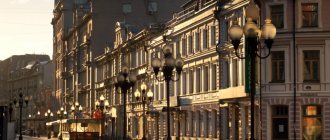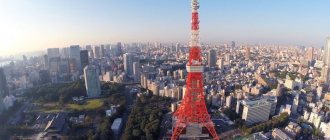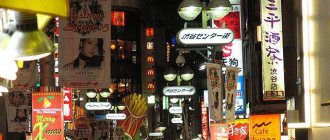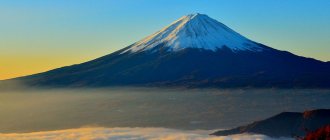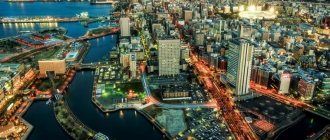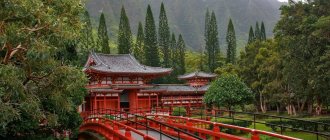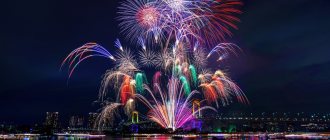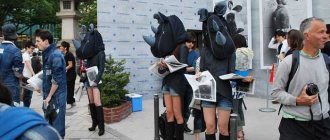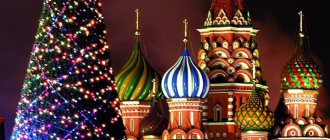Imperial Palace
The Imperial Palace is the main and most popular attraction in Tokyo. It has been located on the territory of the former Edo Castle since the mid-19th century. The fortress in the center of the metropolis includes 2 ground floors and 1 underground. Massive walls and wide ditches isolate this symbol of statehood from the bustle of the metropolis and simply attract the attention of tourists. The architecture is in a traditional style, restrained and simple. Unfortunately, you can only admire this majestic building from afar. Entrance to the palace for outsiders is prohibited. But even from a distance, the imperial palace is remembered for its grandeur and aura of power.
Shinjuku Imperial Park
Shinjuku Imperial Park is the most beautiful place in Tokyo. Founded at the beginning of the 20th century, the park first belonged to the imperial family. Only since the middle of the century was access here open to everyone. The amazing layout of the garden divides it into 3 parts. A Japanese garden with a tea house sets the mood for contemplation. The English and French parts are reminiscent of Old World landscape finds. More than 10,000 trees delight you with their blooms in spring; in summer you can’t take your eyes off the blooming hydrangeas and myrtle. In autumn, lilies and chrysanthemums bloom. The winter landscape makes you freeze in admiration, as if in front of a painting by a great master.
What to see in Tokyo in a week
Sakura blossom
In seven days in the city you can see all the main attractions and enjoy the hospitality of the capital of Japan. Among the compulsory programs, it is worth paying attention to Buddhist temples and monasteries, visiting sumo fights, parks and national museums.
Miraikan (Museum of the Future)
Miraikan (Museum of the Future)
To understand why the capital of Japan is called the city of the future, just come to Miraikan - the National Museum of Advanced Science and Technology. The museum contains all the latest achievements of Japanese scientific thought in the field of genetics, robotics, chemistry, and medicine. The ASIMO robot is a constant success among visitors because it can perform complex tasks, for example, it can hit a ball or carry on a conversation with a person. The museum is interactive, all the exhibits can and should be touched, tried, pressed buttons and studied in every possible way. Here you can also feel like a pioneer and dive to the seabed in a submarine. Or conquer the silent space of space. A number of exhibits will allow you to “survive” an earthquake and even a storm.
Sumida River Cruise
Sumida River Cruise
To see the city from a new perspective, take a river cruise. The duration of the trip depends on the chosen route. The shortest cruise lasts only 30 minutes. Of course, the Sumida River is not the most beautiful river in the world. It cannot be compared in any way with the canals of Venice, nor with the canals of Amsterdam or St. Petersburg. But from the river you can see all areas of the city.
Kamakura
Kamakura
This is one of Japan's ancient cities and is ideal for a day trip from the bustling capital. Kamakura is known for its amazing architecture. The city is home to several Buddhist temples that are significant for Japan. These are Engaku-ji Temple and Tsurugaoka Hachimangu Temple. The second largest Buddha statue in Japan is also located here, its height is over 11 meters and its weight exceeds 90 tons. All Kamakura temples are integrated into the surrounding landscape: green hills rise on three sides, and the sea on the fourth. Nearby there are ponds in which white and red lotuses grow.
Meiji Shrine
Meiji Shrine
Meiji Shrine is dedicated to the Japanese Emperor Meiji and his consort. Unlike Senso-ji Temple, this is a Shinto shrine. The temple appeared at the beginning of the 20th century, but did not last long. The fighting during World War II led to the complete destruction of the temple. After the end of the war, the temple was restored, and a classical Japanese garden was laid out around it. There is a relaxed and serene atmosphere here, where you can take a pleasant break from the noise of the big city.
Restaurant Robots
Restaurant Robots
One of the most interesting places in the capital of Japan is the Robots restaurant, which hosts demonstrations of robotics and live actors and dancers. The establishment does not offer haute cuisine, but here you can watch a unique musical and theatrical performance. During intermission, don't forget to take a photo with the performance participants.
Onsen (hot springs)
Onsen (hot springs)
Another element of traditional Japanese culture is visiting hot springs. In a country where high volcanic activity remains, thermal springs are found everywhere. It is customary for families or large groups to come here. Oedo Onsen Monogatari offers visitors not only relaxation in hot water, but also massage. Here you can also try sake or find out your future from a fortune teller.
Yokohama
Yokohama city
If you are in Tokyo for several days and are thinking about exploring the surrounding area, then visiting Yokohama would be your best choice. It is rather not a city, but a suburb of the capital of Japan. Yokohama is only 30 km away. The Port of the Future is being built on the reclaimed territory by the sea. The Silk Center offers you to purchase goods of the highest quality, and the Silk Museum will tell you and show you the process of producing openwork fabrics that are used to make kimonos. An impressive Ferris wheel will show you the city from a height of several hundred meters. Finally, you can stroll through authentic areas of Yokohama, such as Chinatown.
3. Ginza District
Ginza is the most expensive and fashionable district of Tokyo, as well as a popular attraction of the city. It has a reputation as one of the most luxurious shopping areas on the planet. The abundance of restaurants, boutiques and shopping centers is amazing. Representative offices of famous world brands are located here. The area got its name from the mint founded during the Edo period, after which master jewelers opened their shops here. And from the end of the 19th century, the area began to acquire its current features. Apparently, the jewelers were not mistaken in choosing the location, since to this day the Ginza area can rightfully be called “golden”.
Shibuya area ⇧
Famous crossroads ⇧
Then we went to Shibuya and saw the famous intersection with a crowd of Tokyoites.
Monument to the dog Hachiko ⇧
Tokyo, monument to the dog Hachiko
Tokyo, Shibuya area
Stores ⇧
A lot of impressions from the 109 shopping center - an eight-story building of shops only for women, CROWDS of Tokyo, you can’t squeeze through, consultants are inviting everyone to their department, plus the music is blaring, which gives you the feeling of a “Chinese” bazaar. In the fitting queues for “coupons”, at the checkout too, on the top floor, 3 schoolgirls painted as Barbie (like from an anime cartoon) are playing at the DJ console.
Clothing sizes ⇧
Also in the store there are mostly sizes M (but for ours it’s S) and S (=XS), and most often only M, young Japanese women mostly have one size)))
Japanese ⇧
For Japanese women, Barbie is generally a cult in my opinion, both in clothes and makeup, a lot of girl dolls.
Tokyo, Barbie from store 109
Evening Shibuya ⇧
In the evening we walked around Shibuya again, it was beautiful and crowded, and then we went to bed, we were very tired.
Tokyo, Shibuya area
Tokyo, Shibuya area
Tokyo, Shibuya area
Tokyo, Shibuya area
Vlada fell asleep while walking according to her schedule.
Kabuki-za Theater
The Kabukiza Theater is one of Tokyo's main cultural attractions. The originality of Japanese culture is clearly visible in the performing arts. Initially, entry to the theater stage was closed to women. All roles were played by men, using complex makeup and bulky costumes. The Kabuki-za Theater is located in the Ginza district and at first looked like a simple wooden structure. Later, the theater's home became a baroque building that was destroyed during the hostilities of World War II. And only in 1950 it received its modern appearance. Music, drama and dance form a surprisingly bright and colorful performance, sometimes lasting several hours.
Toyota Mega Web Exhibition Center
The Toyota Mega Web Exhibition Center is one of the most interesting places in Tokyo, especially for car enthusiasts. It is located on the island of Odaiba, in the Palette Town entertainment center. The exhibition center tells about the history of the formation and development of the Japanese automotive industry. Entering the museum's vaults, visitors find themselves in the wonderful world of cars, from the very first models that seem to have rolled off the assembly line yesterday to the latest developments. You can even ride on many models. The main part of the exhibition is focused on the history of the development of the Toyota brand. Not only well-known models are presented, but also those that did not go into production. Rare cars occupy a separate room; exhibits in the following rooms tell about the features of the cars. Test drives for children and adults allow you to ride right through the pavilions.
Where to go in Tokyo with children?
- Monkey Park (Takao, Hachioji, Tokyo);
- "Aqua City Odaiba" (Odaiba Island);
- Ferris wheel (Odaiba Island);
- Tokyo Aquarium (Tokyo Tower);
- Thunder Dolphin roller coaster (Tokyo Dom City);
- Tokyo Toy Museum (Shinjuku, Tokyo);
- Disney Store (Tokyo);
- Ueno Zoo (Ueno Park);
- Tokyo Disneyland.
Ferris wheel
After reading this story and finding yourself in Tokyo, you will know what you need to see here, and what - if you have free time and resources.
We hope you enjoy the trip. You can share your impressions of the main attractions of Tokyo, their photos and descriptions, as well as additions to the proposed routes in the comments.
Disneyland in Tokyo
When you are in Tokyo, be sure to visit one of the largest parks in the world - Disneyland. It is located on the outskirts of the capital. From afar, it can be mistaken for the embodiment of a fairytale dream. However, the park's attractions are quite tangible and will not leave any visitor indifferent. The change of scenery makes your head spin: the African jungle gives way to a ballroom, which immediately turns into a spaceship, and now an old train is slowly taking you towards new adventures.
Tokyo Disneyland opened in the spring of 1983 and has already welcomed more than 300 million people. The annual renovation of the park maintains its attractiveness for tourists. The territory is divided into several thematic sectors, and parades and celebrations with the participation of Disney characters are regularly held in all sectors of the park. At night you can see a fireworks show accompanied by music. The festive atmosphere of this park will live in your memories for a long time.
Miraikan Museum
This Tokyo landmark showcases the technology of the future. The creator of the museum is considered to be the Japan Science and Technology Agency. The first impression is admiration for human thought, which covers a wide range of issues. The most daring scientific projects have found their embodiment within the walls of this Tokyo landmark. The exhibition occupies 6 floors and is divided into separate themes. Many areas are interactive; most of the exhibits can be touched with your hands. Several times a day, the humanoid robot ASIMO performs at the Miraikan Museum. He talks, goes up the stairs and plays with a ball. The museum hosts lectures and shows films.
Which museums in Tokyo are worth visiting?
Tokyo, whose attractions include not only modern values, is the cultural capital of Japan:
- Miraikan Museum presents expositions of all scientific and industrial achievements of Japan. All exhibits can be interacted with, touched, twisted and used. Viewing all exhibitions in the museum takes from 1 to 6 hours. In total, the building has 6 floors, on each of which you can get acquainted with the latest technologies of the modern world. The main exhibit is the robot ASIMO, it can not only talk with visitors, but also walk around the museum, hit a ball and do things that are simple for any person.
- The Toyota Mega Web Museum contains everything you need for those who are interested in cars and motorsports. The entire exhibition consists of 6 parts, each of which is dedicated to a specific topic. There are the first historical Toyota cars, Formula 1 cars, concept cars that will never go into mass production. On site you can choose one of the modern cars and, if you have a driver’s license, test drive it in a special pavilion. There is a special kart for children where they can ride on a specially equipped track 150 meters away. The cost of visiting this museum is 300 yen.
- The Edo Museum is located near Ryogoku Station. In it you can view all the historical cycles of Japan from antiquity to the present and even the possible future of the country. At the exhibition you can see devices that were used by the first people on the territory of modern Japan.
- National Museum of Tokyo consists of 3 complexes with exhibitions dedicated to Japanese art. The exhibits are originals of the country's ancient culture; some can be photographed, while for others photography is strictly prohibited. In the museum you can find: sculptures, jewelry, money, weapons, armor, and other items of national art. Some of the exhibits date back to the 7th century. The entrance fee for adults is 620 yen, and for children 410. Opening hours: 09:00 - 21:00.
- The museum is dedicated to the first animation studio Ghibli , founded in 1985 by famous director Hayao Miyazaki. To visit this place, you should book tickets in advance, since the exhibition is visited not only by a large number of tourists, but also by local residents. Throughout the museum there are full-length figures of all the animated characters of this studio, as well as sketches and design drawings. You are not allowed to photograph the exhibits; there is a souvenir shop right in the building where you can buy your favorite character as a souvenir. The museum is located near the Mitaka metro station.
Tsukiji Fish Market
The Tsukiji Fish Market resembles a natural science museum. Japan is so rich in seafood that sometimes you forget that this is not the seabed, but shopping arcades. More than 400 species of marine life can be found on the shelves. Daily trade turnover reaches 2 thousand tons of fish and seafood. The market is located almost in the city center. His day begins at 4 a.m., when a bustling movement of workers fills the area with shouts and laughter. The most impressive spectacle is the tuna auction, which starts at 5 am. Huge carcasses of the freshest fish are sold and bought by connoisseurs in a few minutes. And when the first employees appear in the offices, the fish market is already finishing its working day. The outer part of the market operates in a completely different mode; it welcomes guests with a variety of goods and a calmer rhythm of existence. Here you can try many local dishes in small cafes and restaurants.
Top 10 most interesting sights in Tokyo
Tokyo, whose attractions are located roughly in the center of the capital, has 10 main places to visit:
- Imperial Palace. One of the oldest existing buildings that can be found on the territory of modern Tokyo. The emperor and his family still live in this palace. The imperial estate is located in the city center, not far from the local train station. Today, the emperor has indirect power, but local residents respect the tradition of the monarchical post held. At the moment, the palace is closed for internal visits, and only on January 2 and December 23 it opens for excursions. But tourists traditionally gather here to watch the cherry blossoms. The park area is open from 10:00 to 15:00.
- Tsukiji Fish Market. This place attracts many tourists every day with massive purchases of tuna in the country, and auctions are also held for the sale of rare types of fish products. The entire market is divided into 2 parts: internal and external. In part 1, wholesale purchases and auctions are held, and part 2 is made for everyone who came to look at the variety of choices and purchase fresh fish. In addition to a wide variety of seafood products, there are cafes and restaurants here that offer to try dishes directly from fish on the shelves.
- Rainbow Bridge. This suspension bridge was built in 1993. It connects the capital with the island of Odaiba. Much attention is paid to this building at night and in the evening, when it is illuminated with lights. The color of the glow varies depending on the time of year.
- Odaiba Island. Residents call this place the island of the future or garbage island. Until 1990, this area was used as a waste storage area. After some time, due to the low efficiency of the landfill, this land was sold to private companies and today it is a modern part of Tokyo. There is a copy of the Statue of Liberty, which is reduced by 4 times, a Gundam robot and many exhibition centers.
- Ueno Park. This park is located near the Ueno train station and is considered one of the largest in all of Tokyo. This park area was originally conceived as an imperial botanical garden and was organized in 1837. It contains many plants from all over Japan, as well as a large number of sakura. In the park there are 4 museums and temples, and there is also a zoo with local animals.
- Tokyo Tower. One of 2 TV towers in Tokyo. The total height is 333 m, it was built in 1958 and at that time was the tallest steel structure in the world. At the very top there is an observation deck where you can admire Tokyo views. The ride up there costs 600 yen, and opening hours are from 09:00 to 23:00. The tower was no longer used in 2011 due to the construction of a taller one.
- Sky Tree TV Tower. This tower was opened in 2012, and its height exceeds 1 television tower almost 2 times and is 634 m. In the evening and at night, it begins to glow in 2 colors: blue and purple. Opening hours from 08:00-22:00.
- Disneyland. Tokyo has Disneyland, the first in the world to be built outside the United States. It is located not exactly in Tokyo, but in the nearby city of Urayasu. Tokyo Disneyland is practically no different from its counterparts around the world. In the center of the park is the princess's castle and the adjacent 7 entertainment areas with themed attractions, shops, cafes and restaurants. Admission for adults is 7,400 yen and for children 6,400 yen.
- Meiji Shrine. The largest Shinto shrine in Tokyo. There is a garden area around the temple where various sporting events are often held.
- Thematic areas. Tokyo has several interesting districts, each of which is of interest to a specific target audience. In total there are 5 main ones:
- Shinjuku - the center of Tokyo with a large number of skyscrapers and office premises;
- Ginza is one of the most expensive places where you can find all the world's brands;
- Harajuku is the area where you can try all the traditional street food of Japan;
- Akihabara - the streets of this area are heavily lit, and also have many references to anime;
- Shibuya is a relaxing area with many shops, cafes and restaurants.
Tokyo Tower
Japan accepts world ideas and successfully assimilates them. This is what happened with the TV tower. The Eiffel Tower was taken as a basis, but scientists managed to lighten it by almost half and make it seismically resistant, which is important in a country that is constantly slightly “shaken.” Erected in 1958, Tokyo Tower has become one of the symbols of the capital. In addition, it carries most of the digital broadcasting load in and around the city.
When sightseeing in Tokyo, be sure to add this place to your list. Here you can climb to observation platforms that offer a 360-degree view. A four-story building was built at the foot of the tower. It houses a wax museum, one of the best aquariums in Japan, an exhibition of optical illusions, a restaurant and several souvenir shops.
Things to do in Tokyo. Interesting places.
Most travelers who travel to Japan head first to the capital, Tokyo, one of the largest cities on Earth. If you are also heading there but don't have any plan yet, then this post should help you. In it we list interesting places in Tokyo, visiting which is a must for a real acquaintance with the city. And if you already have a plan, you can compare it with this list.
View the city from a bird's eye view
Tokyo is a gigantic urban formation that has absorbed a lot of small towns and villages. And you can fully feel this only by climbing to a higher point. Landscapes with streets stretching to the horizon will definitely remain in your memories for a long time.
There are many different viewing platforms in Tokyo.
Tokyo Skytree
Probably the most advertised is the Skytree - the world's largest television tower with a height of 634 meters . Among man-made structures, only the Burj Khalifa in the UAE is taller. Observation platforms are located at an altitude of 350 and 450 meters, and you need to buy a separate ticket for each.
Despite its outstanding height, the Skytree may not be the best use of your time and money. Huge queues for tickets, huge crowds of people inside and a hefty price of 2060 yen for access to the first platform (350 m) with an additional 1030 yen to go up to the second higher platform (450 m). Yes, the views from this tower are impressive... But can you enjoy them while maneuvering through a crowd of similar visitors? And the main problem is that from Sky Tree you can’t see the tower itself!
The tower is open seven days a week from 8:00 to 20:00.
Tokyo Tower
An obvious alternative is Tokyo Tower . An older structure that appeared on the Tokyo map in 1958, it is located in the busier Minato area. Although the Tokyo Tower is significantly lower than the Sky Tree, it offers equally impressive views of areas with skyscrapers and multi-level expressways. In addition, access to the observation deck, located at an altitude of 145 meters, is much more affordable - only 900 yen . The money saved can be spent, for example, on delicious crepes filled with cream, ice cream, chocolate and fruit at the Marion Crepe kiosk near the base of the TV tower. Surprisingly, these pancakes, in which all sorts of goodies are wrapped, have also become one of the symbols of Tokyo, although the dish, judging by the name, has French roots.
Once you've reached Tokyo Tower, be sure to stop by the Zojoji Buddhist Temple nearby (map). This is an amazing place, where peace and harmony are dissolved in the air, and the proximity of the red openwork beauty creates an interesting feeling - thousand-year-old traditions and modernity intersect here. In fact, almost all the temples look approximately the same, but only here the Tokyo Tower serves as the backdrop for the main pavilion.
Tokyo Tower is also open seven days a week from 9:00 to 23:00, but they stop letting you into the site at 22:00, so come early.
Mori Tower in Roppongi Hills
Not far from Tokyo Tower is the Roppongi area, famous for its abundance of restaurants, cafes, bars and other entertainment venues. This is where foreign tourists most often come in search of the capital's nightlife. You can take this into account, but now I suggest you move to this area with another goal - to see Tokyo from another high point.
From Tokyo Tower to Roppongi it is only a 15-minute walk. By the way, the road lies past the Russian Embassy in Japan (map), but, frankly speaking, there is nothing more to say about it: the territory is fenced, there is nothing noticeable, except that you can photograph the fluttering native tricolor.
Our destination in the Roppongi area is the Mori skyscraper (map). There is an observation deck on the 52nd floor. In addition, there is access to the roof, where you can not only see, but literally feel the surrounding city with your whole body. The roof is safe because the edges are securely fenced. But during strong winds and rain, access to it may be closed.
Why climb to this observation deck? Firstly, it is located in an extremely busy area. If you're there in the evening, you'll be able to capture the neon-lit streets of Tokyo at night. Secondly, from this site you can see both attractions that were described above - Tokyo Tower is closer, and Sky Tree is visible in the distance. Both of these structures strongly define the image of the city, so the observation deck in the Mori Building offers a good opportunity to take interesting photos with both towers.
This observation deck cannot be called cheap, it costs 1800 yen, and a ticket with a visit to the roof is 500 yen more expensive . Open daily from 10:00 to 23:00, but the roof closes an hour earlier.
Tokyo Municipality
If spending money is not your choice or it’s simply not possible, but you still want to see Tokyo from a bird’s eye view, then there is a free option . In the Shinjuku area there is a skyscraper of the Tokyo Municipality - a huge building topped with two towers (map). Its shape is memorable from the first time, and once you see it, you will notice it in so many shots from Tokyo. It is in this building that there is a free observation deck on the 45th floor. Even two - one in each tower.
Despite the fact that access to it is free (you just need to contact local employees who already know what you need and will immediately take you to the desired elevator, where the conductor will be waiting), this site, in general, is not much inferior to others. The Shinjuku district in which it is located is one of the central ones, and life is constantly in full swing here . The only downside may be that the municipal building is located among a cluster of skyscrapers, so in some places they block the view. On the other hand, this can be a plus, because it greatly contributes to creating the atmosphere of a metropolis.
Recommendation : Before going up to the site, mark on the map some points of interest in the Shinjuku area and try to find them, looking at the city from above. This is both practical, because this way you can understand how to get to the right places, and just interesting, because a city on a map, a city at street level and a city from a height of 202 meters are three very different cities. If you have extra time, it might make sense to visit this observation deck at the beginning of your trip and at the end, when you are already more familiar with the city. It would be interesting to compare impressions, although, of course, this may not be possible if the time is scheduled by the hour.
Admission is free , the south tower is from 9:30 to 17:30, the north from 9:30 to 23:00, but they stop letting you in half an hour before closing. Both towers are not always accessible; they close periodically according to the following schedule: the southern one is closed every first and third Tuesday of the month, the northern one is closed every second and fourth Monday of the month. It's a little confusing, but you can figure it out if you want to hit both towers exactly.
Immerse yourself in the history of Tokyo
Despite the fact that the capital of Japan is considered a metropolis of the future, Tokyo is a city with a rich history and, of course, every tourist should touch it.
Imperial Palace
Japan has the oldest dynasty of monarchs in the world. It has never been interrupted in the entire history of the country, that is, one can trace family ties between the current Emperor Hirohito and the rulers who lived one and a half thousand years ago. And the main residence of this family is located in the very center of Tokyo - this is the Imperial Palace (map).
This is a must-visit place to feel the spirit of ancient Japan. It’s worth starting with the fact that the territory of the palace and the adjacent park is surrounded by a deep and wide moat with water, where you can see colored carps, turtles and ducks. This is a real medieval fortress in the middle of a metropolis - a green spot on the map is surrounded by orderly rows of modern office buildings. In fact, such contrast is an integral part of modern Japan - here the traditional goes hand in hand with the modern.
Getting to the territory of the imperial palace is not so easy - access is only by appointment, after which on one of the days from Tuesday to Saturday a guide will take you through the palace buildings. The excursion is conducted in English (and this began only in the spring of 2018; before that, excursions were only in Japanese).
The garden is directly adjacent to the palace. Access to it is free , but it leaves no less an impression, especially if you love parks and gardens. In this place, you can feel how much effort is put into organizing the space: open lawns give way to shady groves, streams flow somewhere, birds sing somewhere. The garden in ancient Japan was a miniature model of the world, and the park at the imperial palace in Tokyo is truly a real world.
Asakusa area
Another historical point is the Asakusa district , where the famous Kaminari Gate is located (this is another one of the sights of Tokyo that you may not know about before arriving, but after visiting you will constantly notice in many images of the Japanese capital) and the Buddhist temple Sensoji (map), which appeared here in 645! Yes, this place is over a thousand years old!
Asakusa now, despite its long history, is a very tourist area, but this is precisely why it is interesting to us. The historical place has adapted to modern reality, and now in one place you can try several tourist and at the same time very Japanese entertainment:
- Stand under the huge lantern of Kaminari Gate and take several bright photographs, trying to catch a moment when there are not too many strangers in the frame;
- Walk along the shopping arcades of Nakamise Street and look at the local souvenirs (prices here are also touristy, so buy carefully);
- Standing in the smoke of incense in a special vat in front of the temple brings health, good luck and wisdom (just don’t blow or touch incense sticks, it’s indecent);
- Get a piece of paper with a fortune (omikuji) - this can be done at the boxes to the right of the pavilion, instructions in English are nearby, or you can simply repeat after other people, and the predictions themselves, although originally Japanese, are duplicated in English;
- To ask Buddhist deities to fulfill your wishes - to do this, you need to throw a coin into a special place in the pavilion (there is a special box there), clap your hands twice and, holding your hands in prayer, silently ask for something;
- Take a walk through the temple garden;
- Try on a kimono - there are shops nearby that rent kimonos, this is a good opportunity to take interesting photos in such a place. And don’t listen to those who think that Europeans shouldn’t wear kimonos because it’s disrespectful to the culture: the Japanese themselves are very happy that foreigners show interest in their culture, including traditional clothing;
- Eat something tasty - in the Asakusa area there is a large concentration of various small establishments with local food, you are sure to find something interesting;
- Ride a rickshaw - guys with toned legs usually wait near Kaminari's gate;
- To look at the complex of unusual buildings on the opposite side of the river - to do this, you need to move from the temple to the river, and from the shore you will see a view of several interestingly designed high-rise buildings (including the Asahi office with a “golden turd” on the roof) with the Sky Tree tower in the background.
In short, you can spend many hours in Asakusa constantly doing something interesting. In addition, there is a Tourist Center (map), where you can go to get additional information about the area and the city in general, find out the schedule of excursions, get maps of the area, and also just sit and relax in the cool or warm, depending on what time you are in. season you will come to Japan. And the Tourist Center simply looks interesting - bright modern architecture combining glass and wood.
Meiji Shrine
There are two main religions in Japan - Buddhism, which came from India via China, and Shintoism, a set of traditional beliefs that have existed on the islands since ancient times. In society, there is no division between these movements, because the Japanese approach religion completely differently from the Europeans, and do not choose one thing, but intertwine everything in the most incredible combinations. However, Buddhist and Shinto holy places look different. And if in Asakusa you can see a typical Buddhist temple, then Meiji-jingu, our next historical point, is a classic Shinto shrine (map). And this despite the fact that it is relatively young and was created only in 1920!
Even in a city as large and modern as Tokyo, shrines can be found on virtually every corner, but few can compare to the Meiji Jingu Shrine. It is located near Harajuku.
To enjoy a walk through the sanctuary, you need to know very little: at the entrance to the sanctuary there are huge characteristic torii gates, which symbolize the transition from the ordinary world to the world of the gods; on the territory of the sanctuary there may be trees with ropes and ropes tied on their trunks, often decorated with paper in the shape of a zigzag - these are the habitats of the gods (one can also say that the trees themselves are the deities); you will definitely come across huge racks of barrels painted with hieroglyphs - these are barrels of sake, which producers from all over the country donate to deities (yes, Japanese gods, like the Japanese themselves, are not averse to drinking); Almost all the buildings on the territory of the sanctuary have a religious function; no one is allowed to enter them.
Meiji Shrine is a popular location for traditional weddings, so you may also be lucky enough to see the bride and groom in traditional attire.
Edo-Tokyo Museum
Incorrectly, the most historical place in any modern city is the local museum, which carefully preserves antiques. In Tokyo, this is the Edo-Tokyo Museum (map).
The museum is open from 9:30 to 17:30.
Edo is the ancient name of Tokyo, which the city bore until 1868. The museum shows in detail the life of the capital throughout history, and this is done using a wide variety of means, making a visit interesting for both adults and children. There are a large number of multimedia installations, ancient exhibits, reconstructed homes of representatives of different classes, examples of fine art from different eras, and much more. My personal favorite is the huge scale models of different areas of the city, recreated using miniature buildings, carts and figurines of people. Each resident wears his own outfit and has an individual pose; you can see what he is going to do or what situation he is in. You can spend a lot of time looking at all the many details of these layouts.
To be honest, describing the inside of a museum is not a very rewarding task, because this is a case when it is better to see once than to read a hundred times. It only remains to say that in addition to its fascinating content, the Edo-Tokyo Museum is also distinguished by its unique appearance, it looks like a spaceship.
This is just the beginning
In fact, there are so many interesting and completely different places in Tokyo that you could write a whole treatise about it. However, people have already done this - and there are many guides to Tokyo. Perhaps you should worry about purchasing one of these... I’ll stop here for now, but I think I’ll return to describing the places of this wonderful city more than once and give you many more ideas for trips.
Tokyo National Museum
Among the most popular tourist attractions in Tokyo, the Tokyo National Museum occupies a special place. The giant cultural center includes 5 buildings, where about 90,000 exhibits are stored. 100 thousand m² preserve the memory of the country's history framed by a luxurious landscape. The main building, Honkan, houses objects, costumes and decorations of the Kabuki theater, drawings and painted screens in its exhibitions. The most popular exhibit of the museum for many years has been samurai armor. The ceremonial building was built in 1909. Externally it looks rather discreet, but the interior decoration corresponds to its original purpose. Nowadays, the building has become an educational center. The Eastern building, Toikan, houses exhibits from many countries; they symbolize the cultural ties of the country. The Heisei building is relatively young, it was built in 1999. Its exhibition includes treasures from the largest Horyu-ji temple in the city of Nara.
Ueno Zoo
Ueno Zoo is the best place in Tokyo to visit with children, after Disneyland of course. It became Japan's first zoo and opened in 1882. Now it is home to more than 400 species of animals. The most famous inhabitants are giant pandas. Zoo staff are conducting serious research to preserve the population of these rare animals. The monorail car will carry you through the zoo territory and save some time for inspecting the enclosures. At the zoo you can visit the Museum of Nature and Science, and a children's petting zoo. Ueno Zoo is one of the 15 best zoos on the planet.
Sights of Tokyo: what else to visit in Tokyo
If after visiting these attractions you still have some free time, be sure to visit:
Studio Ghibli Museum
Totoro in the ticket booth in front of the entrance to the Ghibli Museum Lucius Kwok
A non-standard art museum that will introduce you to modern and already legendary animation: the anime “Howl’s Moving Castle”, “Princess Mononoke”, “My Neighbor Totoro” and other creations of Ghibli developers;
Official website: https://www.ghibli-museum.
Orthodox Cathedral "Nicholas"
Cathedral of the Resurrection of Christ in the Russian-Byzantine style in Tokyo
Services are conducted in Japanese, but the harmonious and unusually clear chants of the local choir attract even those tourists who do not understand the national speech;
Ueno Zoo
Adorable penguins are the inhabitants of the Ueno Zoo.
The territory, which is home to more than four hundred species of animals, including western lowland gorillas and rare Sumatran tigers, is divided into western and eastern parts. We recommend that you go visit reptiles, elephants, polar bears, tigers, giant pandas and other birds and animals for the whole day. Moreover, entry for young children will be free (on certain days);
Official website: https://www.tokyo-zoo.net
Oedo Onsen Hot Springs
Oedo Onsen Monogatari hot spring complex on the island of Odaiba.
The complex includes a cafe and souvenir shops, a steam room and a sauna. But the most important thing is that there are 6 types of baths at once (including mineral water baths, stone and sand baths). The scenery of the hot springs conveys the spirit of feudal Japan. You can take water treatments on the man-made island of Odaiba;
Official website: https://daiba.ooedoonsen.jp
Jozo-ji Temple
Zozo-ji Temple is located directly under the Tokyo TV Tower.
The luxurious pagoda was restored and moved several times to different places. At the same time, the entrance gate of the early 17th century was able to be preserved unchanged. The entrance is guarded by dragons, after passing which guests of the temple find themselves in a charming Japanese garden: with small pagodas, lanterns made of stones and cedars soaring into the sky. There is also a cemetery on the territory, part of which is dedicated to the unborn children of Japan.
Official website: https://www.zojoji.or.jp
Kabukiza Theater
The Kabukiza Theater building in the center of the Ginza shopping district.
One of the types of classical theatrical art in Japan is Kabuki - spectacular performances using flashy makeup, costumes, expressive gestures and actions, in order to convey the meaning of the plot to the viewer. This is an important point, given that theatrical productions use an outdated form of language, which is not easy for the Japanese themselves to understand. A prominent representative of the Kabuki movement is the Kabukiza Theater, which has the status of the most important cultural attraction in Japan. It is located in Tokyo, Ginza district, in close proximity to the city's main shopping street. The building was originally built in 1889, but as a result of disasters and wars it was repeatedly destroyed and reconstructed. The theater seats almost 2 thousand spectators, and the duration of performances sometimes reaches 5 hours.
Official website: https://www.kabukiweb.
Omoide Yokoto Street
Walking along Omoide Yokoto Street in Tokyo Aussie Assault
Omoide Yokoto Street at Night Stephen Kelly
Omoide Yokoto Street with traditional eateries Stephen Kelly
There is hardly a person somewhere who, while traveling around countries, would not want, along with impressions of the sights, to acquire a new gastronomic experience. Especially when it comes to Tokyo, which is considered the world's best foodie destination. A special category in the capital is street food, which allows tourists to satisfy their hunger literally on the go, without interrupting their educational walk. And even if you are already tired of the ubiquitous and familiar fish, noodles and rice and want the usual meat dishes, then in this case, Japanese cuisine will delight everyone. In Tokyo, one of the places that specializes not only in traditional cuisine, but also in quite affordable meat dishes, is the old Omoide-Ekoto alley, where they offer yakiniku - grilled meat dishes. Along this entire street there are traditional eateries with fried meat dishes, among which chicken skewers are especially attractive.
Shitamachi Museum
Shitamachi Museum on the shore of Shinobazu Pond in Ueno Park in Taito Ward
Exhibits of the Tokyo Shitamachi Local History Museum
All the brightness of autumn colors has already faded, and the cherry blossom season is still far away, but what to see in Tokyo in December to compensate for the winter mood in bad weather? It's time to move from contemplating the beauty of the landscape to studying Japan's national treasures in museums, especially since there are a lot of them in Tokyo. There is, for example, the Shitamachi Museum, which demonstrates how people lived in the city's business centers in different periods, starting from the 17th century. The museum collection is presented on two floors: the lower one is an authentic street with reconstructed buildings from the Meiji period, the upper floor represents the interiors of the inhabitants of the old city with ancient artifacts and traditional household items. On the makeshift street, the set of attributes even changes slightly with each season - for example, umbrellas appear in the fall, warm clothes and other cute little things appear in the winter.
Official website: https://www.taitocity
Mori Art Museum
The Mori Art Museum hosts exhibitions by artists from around the world Yuya Tamai
Tokyo museums represent an original combination of ancient traditions and the latest achievements of our time. It is this contrast that allows you to fully comprehend the soul of this unique country. The Mori Art Museum is considered the highest museum in the Japanese capital, as it is located on the upper floors of the 238-meter “Mori Tower”. The creator of the institution is Minuro Mori, who deliberately placed the premises at such a height, thereby emphasizing the importance of art. The museum's collection represents mainly objects of contemporary art - creations of contemporary artists, starting from the mid-20th century, paintings by modern masters, and other thematic exhibits from around the world. Purchasing a museum ticket gives visitors the opportunity to visit the observation deck that surrounds the museum square on all sides.
Official website: https://www.mori.art
National Museum of Western Art
Facade of the National Museum of Western Art in Tokyo
Asia's largest national museum of Western art is dedicated to European art in sculpture and painting. It stores the most valuable collections of works by European masters, starting from the Middle Ages and ending with the beginning of the 20th century. Most of them were acquired by the museum's organizer, Kojiro Matsukata, during his travels throughout Europe, especially in Paris. During this time, he collected about 2 thousand European and about 8 thousand Japanese works of art, and the design of the museum building was drawn up by a friend of the collector, artist Frank Brengwin. Currently, in the museum you can see not only the Matsukata collection, represented by 370 items, but also other exhibitions prepared by museum specialists. In addition to the exhibitions themselves, classical music concerts, lectures and international meetings are regularly held here.
Official website: https://www.nmwa
National Museum of Nature and Science
Japanese Gallery of the National Museum of Nature and Science in Ueno Park
Exposition of the Global Gallery of the National Museum of Nature and Science
Late autumn is a time when the tourist flow in Tokyo decreases; it pleases with the absence of fuss and crowds near attractions. Therefore, Tokyo autumn can also find its advantages and choose what to see in Tokyo in November. While the November nature does not please with colors, it’s time to see nature, but within the walls of a museum. The National Museum of Nature and Science will delight visitors of all categories and ages: from fans of scientific tricks to those who just want to spend a rainy day usefully. Its exposition is striking in its diversity - there are more than 14 thousand exhibits here, telling about the environment, space, light, sound, magnetism, movement as important natural phenomena. Of special note is the exhibition on the origin of the Universe, the evolution of earthly life, and the exhibition on the flora and fauna of Japan.
Official website: https://www.kahaku.
Akasaka Palace
Akasaka Palace in the neo-Baroque style is now the State Guest House of the Government of Japan
When the city is covered with bright carpets of autumn leaves, it’s time to go to the parks that decorate the outskirts of Tokyo - picturesque walking alleys, blooming botanical gardens and cozy squares on the outskirts of the city. By visiting park areas in the vicinity of palaces, you can combine a pleasant walk in nature with contemplation of the magnificent architecture and interiors of a historical building. There is no question about what to see in Tokyo in October if you already imagine how beautiful Akasaka Palace looks surrounded by a park painted in magical autumn colors. The grandiose architectural complex, built at the turn of the 19th and 20th centuries, is located in a quiet and peaceful area of the metropolis. Akasaka is the largest building of the Meiji era and the only neo-Baroque building in Japan. Its interior decoration is a treasure trove of masterpieces by sculptors, artists, weavers and furniture designers.
Tokyo Station
Tokyo Station is the main intercity train station in Tokyo.
Tokyo Station, located in the Chiyoda Ward, is the city's main train station and a major transportation hub serving urban and commuter trains. The historical station building, erected in 1914, is made in retro style from dark red brick, its domes are decorated with bas-reliefs. The infrastructure of the station is amazing in its scope - both underground and on its surface there are a large number of shops, restaurants serving Japanese, European and Chinese cuisine, souvenir shops, there are even beauty salons, supermarkets and hospitals. And of course, the main thing is that high-speed trains and subways depart from here along a network of intricately intertwined railways. For example, you can take the Shinkansen bullet train to explore the authentic sights of Kyoto, in contrast to the mind-blowing creations of the modern, thriving capital.
Official website: https://www.tokyoinfo
Rainbow Bridge
Rainbow Bridge illuminated at night across northern Tokyo Bay
In general, a holiday in the Japanese capital is considered expensive, but here you can save money and see free attractions in Tokyo , which will both leave an impression and save your savings. Such objects include the Rainbow Bridge - one of the modern symbols of the city, which thousands of tourists from all over the world come to admire. It is a huge suspension bridge connecting one of the city's business districts with the artificial island of Odaiba. The two-tier structure is more than 900 meters long, more than 120 meters high, and there are observation platforms at the very tops of the pylons. When imagining the Rainbow Bridge, everyone imagines something bright and colorful, but this is not entirely true. The bridge is painted white, and only at midnight the illumination works magic on it - it turns rainbow, lighting up with colored lights.
Official website: https://www.shutoko.
Kabukicho Quarter
The Kabukicho quarter is a famous entertainment district in Tokyo's Shinjuku district. Daniel Ramirez
Multifaceted Tokyo is also home to a whole quarter of dubious entertainment on its streets. Kabukicho is a neon-lit red light district filled to the brim with sex shops, arcades, love hotels, and located right next to Shinjuku Station. A century ago, the history of the area could have taken a completely different direction - a residential area was planned within the area, and it was here that the Kabuki theater building was originally going to be erected. But problems with financing did not allow this plan to be realized, and the name for the quarter was already assigned. The abandoned territories were bought up by the Chinese, who carried out large-scale development here in a completely different way. These days, the area comes alive after 6 pm, and you shouldn’t bypass it - in addition to entertainment, there are a number of decent restaurants and cafes, mainly serving fresh seafood dishes.
Now you know what attractions in Tokyo every visitor to the country should see with their own eyes. Before going on excursions, be sure to check the entry conditions and opening hours of memorable places and entertainment and cultural institutions.
Senso-ji Temple
Senso-ji Temple is the oldest Buddhist temple in Japan, dating back to the 7th century. During the Second World War it was destroyed and restored according to drawings and drawings of the 17th century in 1958. Despite its status as a tourist site, the temple is still operational. Pilgrims are greeted by the gate of thunder, which is guarded by two deities: Thunder and Wind. Behind the gate begins a shopping street with souvenir shops. It ends with a two-story gate, where ancient religious books are kept in the treasury. The temple complex itself includes 5 pagodas and a central hall with a statuette of the deity of mercy Kannon. In the evening, when the lights are on, this architectural landmark of Tokyo appears in a fabulous form.
You have already voted
